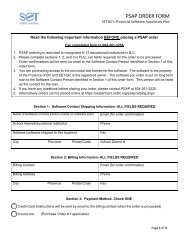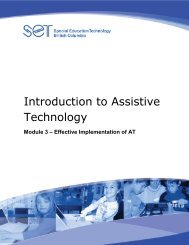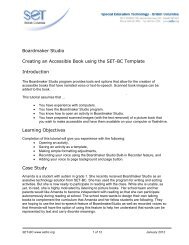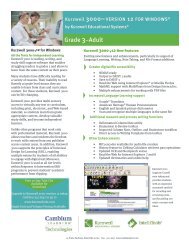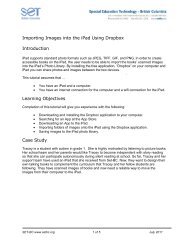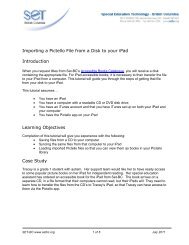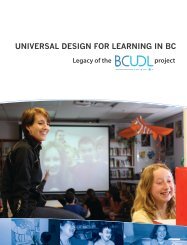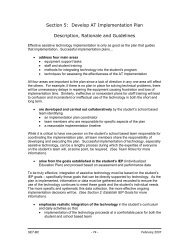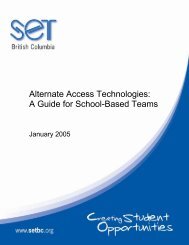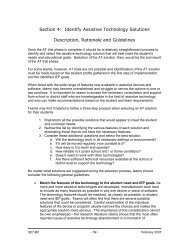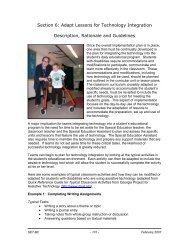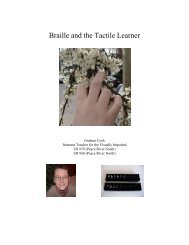Supporting Individuals Using Picture Communication ... - Set BC
Supporting Individuals Using Picture Communication ... - Set BC
Supporting Individuals Using Picture Communication ... - Set BC
Create successful ePaper yourself
Turn your PDF publications into a flip-book with our unique Google optimized e-Paper software.
<strong>Supporting</strong> <strong>Individuals</strong> <strong>Using</strong> <strong>Picture</strong> <strong>Communication</strong> Symbols<br />
by Brenda Fossett, Special Education Teacher of the Deaf<br />
British Columbia Provincial School for the Deaf<br />
Symbol and Behavioural Assessment<br />
Goals of symbol assessment<br />
From Augmentative and Alternative <strong>Communication</strong> - Management of Severe <strong>Communication</strong><br />
Disorders in Children and Adults, Beukelman & Mirenda, 1998<br />
• “to select the types of symbols that will meet the individual’s current communication<br />
needs and match his or her current abilities”<br />
• “to identify symbol options that might be used in the future”<br />
Preparation<br />
From Augmentative and Alternative <strong>Communication</strong> Disorders in Children and Adults,<br />
Beukelman and Mirenda, 1998<br />
• identify 10 functional items with which the individual is familiar<br />
• reach a consensus on the items<br />
• compile symbols for the items, including miniature objects, black and white and colour<br />
photographs, black and white and colour symbol sets<br />
Assessment formats<br />
From Augmentative and Alternative <strong>Communication</strong> - Management of Severe <strong>Communication</strong><br />
Disorders in Children and Adults, Beukelman & Mirenda, 1998<br />
• functional use format<br />
• receptive labeling and yes/no formats<br />
• alternative visual-matching format<br />
• question and answer format<br />
• requesting format<br />
Matching tasks<br />
• real item to object<br />
• real item to photograph<br />
• real item to black and white symbol<br />
• real item to colour symbol<br />
Considerations<br />
• visual acuity<br />
• symbol size<br />
• background/foreground<br />
• visual processing<br />
• 3 dimensional vs 2 dimensional<br />
• photographs vs symbols<br />
• colour vs black and white<br />
October 1998 <strong>Supporting</strong> <strong>Individuals</strong> <strong>Using</strong> <strong>Picture</strong> <strong>Communication</strong> Symbols Page 1
Goals of behavioural assessment<br />
• to determine who the individual is<br />
• to define the behaviour<br />
• to identify setting events and antecedents<br />
• to identify the maintaining consequences or motivation for the behaviour<br />
Assessment tools<br />
Personal Profile Preference Inventory - CBI Consultants, 1994<br />
• assists in identifying the person’s<br />
• preferences and strengths<br />
• preferred activities and environments<br />
• learning style<br />
• assets and deficits in his/her social network<br />
• helps to formulate the “big picture” of the person’s life<br />
Motivation Assessment Scale - Durand & Crimmins, 1992<br />
• a 16 item questionnaire that assesses four main motivators of behaviour<br />
• tangibles<br />
• attention/social interaction<br />
• escape/avoidance<br />
• sensory<br />
Functional Analysis Interview - O’Neill, Horner, Albin, Storey and Sprague, 1990<br />
• to understand the structure and function of the behaviour in order to teach and develop<br />
alternatives<br />
Functional Analysis Observation - O’Neill, Horner, Albin, Storey and Sprague, 1990<br />
• to gather information regarding the frequency of behaviour, the times of day and settings<br />
when behaviour does/does not occur and to record consequences<br />
Scatter Plot - Touchette, MacDonald and Langer, 1985<br />
• to get a visual picture of the pattern of behaviour<br />
<strong>Set</strong>ting Events Checklist - Gardner, Cole, Davidson and Karan, 1986<br />
• to identify setting events that may be influencing the behaviour<br />
Behaviour as <strong>Communication</strong> - Considerations When Designing Supports<br />
Personal profile<br />
• systems that match the individual’s learning style<br />
• systems that use the individual’s strengths and abilities<br />
Motivation of behaviour<br />
• tangible - design systems to support the individual in having his/her needs or wants met<br />
• escape - design systems to allow the individual to ask for breaks, make choices, predict<br />
upcoming events<br />
• attention - design systems to promote social integration<br />
October 1998 <strong>Supporting</strong> <strong>Individuals</strong> <strong>Using</strong> <strong>Picture</strong> <strong>Communication</strong> Symbols Page 2
• sensory - design systems to allow the individual times to engage in sensory behaviours or<br />
to ask for sensory breaks<br />
Schedule Systems<br />
What are schedule systems?<br />
• a way of representing an activity or sequence of events<br />
• a collection of objects, photographs or symbols that represent activities<br />
• can be set up for an entire classroom, a small group or individuals<br />
• can be general or specific<br />
• a way to help upcoming events and make choices<br />
Why use schedule systems?<br />
• to develop expressive and receptive communication skills<br />
• to help individuals anticipate upcoming events<br />
• to provide individuals with an understanding of upcoming events<br />
• to decrease challenging behaviours by allowing for prediction and choice making<br />
What can schedule systems provide?<br />
• communication - receptive and expressive<br />
• anticipation and security<br />
• structure and organization<br />
• order and sequence<br />
• an ability and opportunity to make choices<br />
• motivation<br />
What can schedule systems teach?<br />
• communication skills<br />
• time concepts<br />
• time vocabulary<br />
• use of time pieces<br />
• pre/early literacy skills<br />
What do schedule systems look like?<br />
Object cue systems<br />
• boxes are placed on shelf, left to right<br />
• representational objects are place in boxes<br />
• the individual works through the sequence<br />
• as activities are completed, the objects are placed in a finished box<br />
• photographs or symbols may be paired with the objects<br />
Considerations<br />
• does not allow for portability<br />
• it is sometimes difficult to locate objects<br />
• for those who cannot process photographs or symbols, this is an important<br />
communication tool<br />
October 1998 <strong>Supporting</strong> <strong>Individuals</strong> <strong>Using</strong> <strong>Picture</strong> <strong>Communication</strong> Symbols Page 3
Wall systems<br />
• representational photographs or symbols are sequenced, left to right or top to bottom<br />
• photographs or symbols may be hung on hooks or attached with velcro<br />
• at the end of each activity, photos or symbols are turned over or placed in finished box<br />
Considerations<br />
• not fully portable<br />
• good for those who require large displays<br />
Single page books<br />
• representational photographs or symbols are sequenced in a mini photo album<br />
• at the end of each activity, photos or symbols are turned over<br />
Considerations<br />
• portable - the book can be placed in a fanny pack<br />
• does not show a full sequence; can only show one activity at a time<br />
Binder systems<br />
• plastic pages for slides used to house two inch square symbols<br />
• as activities end, symbols are turned over<br />
• velcro strips are placed on front and inside covers of binder<br />
• symbols or photographs are attached with velcro<br />
• the schedule is shown on the front cover; extra symbols are housed inside the binder<br />
Considerations<br />
• portable<br />
• plastic pockets may be difficult for those with fine motor problems<br />
• binders can become cumbersome<br />
The Portacom System<br />
• worn around the user’s waist<br />
• made of velcro sensitive material<br />
• includes a zippered pocket for placing symbols when activity is finished<br />
Considerations<br />
• designed by a mom of deaf, autistic twins<br />
• lightweight<br />
• hands free<br />
• can also house other visual supports<br />
Incorporating Behavioural Support in Schedule Systems<br />
• Premack principle - preferred activity following a less preferred activity<br />
• choice making - allowing students to exercise control over their day<br />
• time pieces - showing when transitions will occur<br />
October 1998 <strong>Supporting</strong> <strong>Individuals</strong> <strong>Using</strong> <strong>Picture</strong> <strong>Communication</strong> Symbols Page 4
Developing <strong>Communication</strong> Skills<br />
Difficulties in developing signed or spoken communication skills experienced by individuals<br />
with developmental disorders<br />
• processing transient forms of communication (speech/sign)<br />
• articulation<br />
• forming signs correctly<br />
• shifting and reestablishing attention<br />
• attending to speech while blocking out background noise<br />
• recall<br />
Benefits of using picture communication symbols<br />
• visually non-transient<br />
• easily understood by the community at large<br />
• assists in focusing attention<br />
• decreases frustration<br />
• easily individualized<br />
Developing communication skills<br />
• establishing a communicative environment - Goossens, Crain and Elder<br />
• engineering the classroom environment to support aided AAC in daily activities<br />
such as circle time, mealtime, food prep, story time, etc.<br />
• communication overlays/grids<br />
• pre-made (Goossens et al)<br />
• self made<br />
• strategic placement in environment<br />
• topic specific communication binders<br />
• identifying topics<br />
• selecting vocabulary<br />
• organizing grids/table of contents<br />
• the <strong>Picture</strong> Exchange <strong>Communication</strong> System (PECS) - Frost and Bondy, 1994<br />
• to teach initiation of interaction to individuals with autism<br />
• training Process<br />
• phase I - the physical exchange<br />
• phase II - expanding spontaneity<br />
• phase III - picture discrimination<br />
• phase IV - sentence structure<br />
• phase V - responding to “What do you want?”<br />
• phase VI - responsive and spontaneous commenting<br />
• errorless learning techniques<br />
• using PECS for receptive communication<br />
• managing PECS<br />
• topic specific books<br />
• PECS books<br />
October 1998 <strong>Supporting</strong> <strong>Individuals</strong> <strong>Using</strong> <strong>Picture</strong> <strong>Communication</strong> Symbols Page 5
<strong>Supporting</strong> home/school communication<br />
• home/school daily schedules<br />
• home/school daily schedules with self evaluation<br />
Behavioural Support Strategies<br />
<strong>Communication</strong> function of behaviour<br />
• tangible<br />
• introduce PECS during activities when behaviour tends to occur<br />
• choice boards to delineate choices<br />
• involve the individual in scheduling<br />
• escape<br />
• Break boards<br />
• attention/social interaction<br />
• communication books<br />
• PECS<br />
• teach peer tutors to use communication supports<br />
• teach individual to play games using PCS<br />
<strong>Supporting</strong> social/behavioural understanding<br />
• consequence maps<br />
• Show the individual two possible “roads” of behaviour and the consequences of<br />
each<br />
• imagery scripts<br />
• walk an individual through a situation, supporting them in making appropriate<br />
choices<br />
• social stories - developed by Carol Gray<br />
• incorporates specific language and writing styles<br />
• written in first person to support individual in understanding social situations and<br />
their role<br />
Literacy Development<br />
The major goals of a literacy program<br />
From Bringing It All Together - A Program for Literacy<br />
Purpose of writing<br />
• a way of recording<br />
• experiences<br />
• information<br />
• imagination<br />
• in order to<br />
• inform<br />
• instruct or direct<br />
• entertain<br />
October 1998 <strong>Supporting</strong> <strong>Individuals</strong> <strong>Using</strong> <strong>Picture</strong> <strong>Communication</strong> Symbols Page 6
Organization of texts<br />
• format<br />
• orientation<br />
• concept<br />
• organizational pattern of various forms of text<br />
• sequence<br />
• components of stories, poems, etc.<br />
Comprehension<br />
• text has meaning<br />
• connect illustrations to text<br />
• relate information from books to our experiences<br />
• make judgments<br />
• predict<br />
• infer<br />
• summarize<br />
Vocabulary<br />
• sight vocabulary<br />
• learning the print form of already known words<br />
• meaning vocabulary<br />
• learning the meaning, sound and visual form of new words<br />
Decoding and encoding<br />
• learning the correspondence between pronunciation and spelling<br />
Difficulties in developing literacy skills<br />
Purpose of writing<br />
• attaching language to thoughts and experiences<br />
Organization of texts<br />
• organizing ideas or information<br />
• organizing words into sentences<br />
Comprehension<br />
• difficulty relating to text, due to limited background experience<br />
• difficulty relating to text due to different perceptions of experiences<br />
• difficulty processing the language level of the text<br />
Vocabulary, decoding and encoding<br />
• difficulty acquiring sight vocabulary due to visual processing difficulties<br />
• difficulty developing a meaning vocabulary due to auditory or language processing<br />
difficulties or hearing loss<br />
Why do <strong>Picture</strong> <strong>Communication</strong> Symbols support literacy development?<br />
• PCS are non-transient, supporting those with auditory processing difficulties<br />
• PCS make a variety of classroom reading activities more accessible to visual learners<br />
How can <strong>Picture</strong> <strong>Communication</strong> Symbols support the development of literacy skills?<br />
Purpose of writing<br />
• expression of ideas, experiences and information<br />
October 1998 <strong>Supporting</strong> <strong>Individuals</strong> <strong>Using</strong> <strong>Picture</strong> <strong>Communication</strong> Symbols Page 7
Organization of texts<br />
• organize ideas and thoughts prior to writing<br />
• provide a framework for grammar<br />
• assist in categorizing parts of stories<br />
Comprehension<br />
• allows for access to print<br />
• enables students to demonstrate their understanding of print<br />
Vocabulary, decoding and encoding<br />
• provides a visually non-transient equivalent to print and through the air language<br />
Strategies for supporting students in developing literacy skills<br />
Purpose of writing<br />
• topic specific grids<br />
• organize information<br />
• brainstorming<br />
• keep focus<br />
• blank comic strips or thought bubbles<br />
• use of symbolized text in daily living activities<br />
Organization texts<br />
• colour coded symbols and similarly coded writing forms<br />
• symbolized organizers<br />
• PECS style writing boards<br />
• IntelliKeys with PCS overlays<br />
Comprehension<br />
• symbolized stories<br />
• activities incorporating the matching of symbols to text<br />
• activities incorporating the matching of symbolized text to illustrations<br />
• comprehension checking activities that do not require through the air language<br />
• story organizers to assist students in summarizing text<br />
Vocabulary, decoding and encoding<br />
• communication environments<br />
• Velcro books<br />
• symbol supported games (bingo, concentration)<br />
• symbolized seat work (matching, crossword puzzles, fill in the blank)<br />
• symbolized picture dictionaries<br />
Adapting and Modifying Classroom Activities for PCS Users<br />
Discussion/brainstorming activities<br />
• topic specific grids<br />
• errorless<br />
• grids that require decision making<br />
• discussion guides/overviews<br />
October 1998 <strong>Supporting</strong> <strong>Individuals</strong> <strong>Using</strong> <strong>Picture</strong> <strong>Communication</strong> Symbols Page 8
Research projects<br />
• PCS graphic organizers<br />
• writing forms<br />
• IntelliKeys/overlays<br />
Novel studies<br />
• transcription<br />
• synopsis of chapters<br />
• adaptation of assignments<br />
Daily writing activities<br />
• morning letter<br />
• symbolized<br />
• cloze<br />
• IntelliKeys with alphabet overlay<br />
• IntelliKeys with PCS overlay<br />
• journal<br />
• PECS style writing board<br />
• IntelliKeys with PCS overlay<br />
Incorporating PCS into Self Help and Daily Living Skills<br />
Dressing, self care routines, bathing<br />
• mini schedules<br />
• communicative environment<br />
Grocery Shopping<br />
• PCS lists<br />
• communication grids<br />
• PECS<br />
Cooking<br />
• symbolized recipes<br />
• communicative environment<br />
• PECS<br />
Restaurants<br />
• ordering forms<br />
• PECS<br />
• communication grids<br />
Chores<br />
• mini schedules<br />
• communicative environment<br />
October 1998 <strong>Supporting</strong> <strong>Individuals</strong> <strong>Using</strong> <strong>Picture</strong> <strong>Communication</strong> Symbols Page 9
References and Resources<br />
Beukelman, David R. and Pat Mirenda. (1998). Augmentative and Alternative <strong>Communication</strong>:<br />
Management of Severe <strong>Communication</strong> Disorders in Children and Adults. Baltimore, MD: Paul<br />
H. Brookes Publishing.<br />
Durand, V. Mark. (1990). Severe Behavior Problems: A Functional <strong>Communication</strong> Training<br />
Approach. New York: Guilford Press.<br />
Frost, Lori A. and Andrew S. Bondy. (1994). The <strong>Picture</strong> Exchange <strong>Communication</strong> System<br />
Training Manual. Cherry Hill, NJ: Pyramid Educational Consultants.<br />
Goossens, Carol, Sharon Sapp Crain, and Pamela S. Elder. <strong>Communication</strong> Displays for<br />
Engineered Preschool Environments, Books 1 and 2. Solana Beach, CA: Mayer-Johnson.<br />
Goossens, Carol, Sharon Sapp Crain, and Pamela S. Elder. <strong>Communication</strong> Displays for<br />
Engineered Training Environments, Books 1, 2, 3 and 4. Solana Beach, CA: Mayer-Johnson.<br />
Goossens, Carol, Sharon Sapp Crain, and Pamela S. Elder. Engineering the Preschool<br />
Environment for Interactive Augmentative <strong>Communication</strong>. Solana Beach, CA: Mayer-Johnson.<br />
Goossens, Carol, Sharon Sapp Crain, and Pamela S. Elder. Engineering the Training<br />
Environment for Interactive Augmentative <strong>Communication</strong>. Solana Beach, CA: Mayer-Johnson.<br />
Gray, Carol. The Original Social Story Book. Arlington TX: Future Horizons.<br />
Gray, Carol. New Social Stories. Arlington TX: Future Horizons.<br />
Gray, Carol. Comic Strip Conversations. Arlington TX: Future Horizons.<br />
Hodgon, Linda A. (1995) Visual Strategies for Improving <strong>Communication</strong>, Volume 1: Practical<br />
Supports for School and Home. Troy, MI: Quirk Roberts Publishing.<br />
Johnson, Terry D. and Daphne R Luis. (1990). Bringing It All Together: A Program for Literacy.<br />
Richmond Hill, ON: Scholastic Canada.<br />
Musselwhite, Caroline and Pati King-DeBaun. (1996). Emergent Literacy Success: Merging<br />
Technology and Whole Language. Park City, UT: Creative Communicating.<br />
October 1998 <strong>Supporting</strong> <strong>Individuals</strong> <strong>Using</strong> <strong>Picture</strong> <strong>Communication</strong> Symbols Page 10



